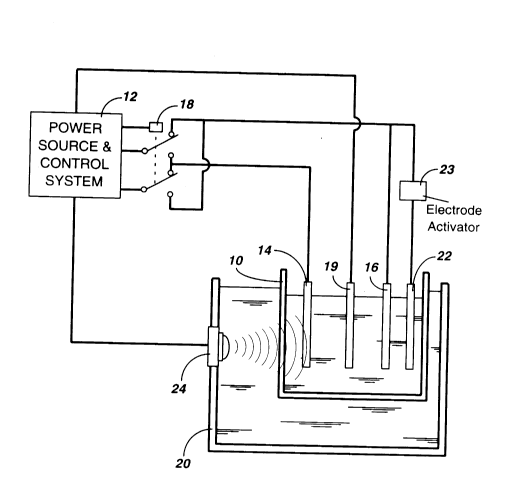Some of the information on this Web page has been provided by external sources. The Government of Canada is not responsible for the accuracy, reliability or currency of the information supplied by external sources. Users wishing to rely upon this information should consult directly with the source of the information. Content provided by external sources is not subject to official languages, privacy and accessibility requirements.
Any discrepancies in the text and image of the Claims and Abstract are due to differing posting times. Text of the Claims and Abstract are posted:
| (12) Patent: | (11) CA 2087801 |
|---|---|
| (54) English Title: | METHOD AND APPARATUS FOR ON-LINE MONITORING THE QUALITY OF A PURIFIED METAL SULPHATE SOLUTION |
| (54) French Title: | METHODE PERMETTANT DE SURVEILLER EN LIGNE LA QUALITE D'UNE SOLUTION DE SULFATE METALLIQUE PURIFIEE, ET APPAREIL CONNEXE |
| Status: | Deemed expired |
| (51) International Patent Classification (IPC): |
|
|---|---|
| (72) Inventors : |
|
| (73) Owners : |
|
| (71) Applicants : | |
| (74) Agent: | GOUDREAU GAGE DUBUC |
| (74) Associate agent: | |
| (45) Issued: | 1996-08-13 |
| (22) Filed Date: | 1993-01-21 |
| (41) Open to Public Inspection: | 1994-07-22 |
| Examination requested: | 1993-05-12 |
| Availability of licence: | N/A |
| (25) Language of filing: | English |
| Patent Cooperation Treaty (PCT): | No |
|---|
| (30) Application Priority Data: | None |
|---|
A method and an apparatus for on-line monitoring
the quality of a purified metal sulphate solution is
disclosed. The method comprises the steps of depositing
metal from the purified metal sulphate solution onto a
working electrode submerged in the solution by passing
constant current through the solution at a current density
in the range of 25 to 150 mA/cm2 for a predetermined time
interval, dissolving the metal deposited on the working
electrode by reversing the polarity of the potential
applied between the working electrode and a counter
electrode so as to pass a reverse current of the same
current density through the solution until all zinc is
removed from the working electrode as sensed by a sudden
change in electrode potential, deriving the quality index
of the solution by calculating the ratio of the
dissolution time over the deposition time, and restoring
the surface of the counter electrode by effecting the
dissolution of the metal deposited on the counter
electrode at the end of each measurement.
Note: Claims are shown in the official language in which they were submitted.
Note: Descriptions are shown in the official language in which they were submitted.

For a clearer understanding of the status of the application/patent presented on this page, the site Disclaimer , as well as the definitions for Patent , Administrative Status , Maintenance Fee and Payment History should be consulted.
| Title | Date |
|---|---|
| Forecasted Issue Date | 1996-08-13 |
| (22) Filed | 1993-01-21 |
| Examination Requested | 1993-05-12 |
| (41) Open to Public Inspection | 1994-07-22 |
| (45) Issued | 1996-08-13 |
| Deemed Expired | 2004-01-21 |
There is no abandonment history.
| Fee Type | Anniversary Year | Due Date | Amount Paid | Paid Date |
|---|---|---|---|---|
| Application Fee | $0.00 | 1993-01-21 | ||
| Registration of a document - section 124 | $0.00 | 1993-07-23 | ||
| Maintenance Fee - Application - New Act | 2 | 1995-01-23 | $100.00 | 1994-11-18 |
| Maintenance Fee - Application - New Act | 3 | 1996-01-22 | $100.00 | 1995-12-19 |
| Maintenance Fee - Patent - New Act | 4 | 1997-01-21 | $100.00 | 1996-11-19 |
| Maintenance Fee - Patent - New Act | 5 | 1998-01-21 | $150.00 | 1997-11-12 |
| Maintenance Fee - Patent - New Act | 6 | 1999-01-21 | $150.00 | 1998-08-31 |
| Maintenance Fee - Patent - New Act | 7 | 2000-01-21 | $150.00 | 1999-12-24 |
| Maintenance Fee - Patent - New Act | 8 | 2001-01-22 | $350.00 | 2001-02-16 |
| Maintenance Fee - Patent - New Act | 9 | 2002-01-21 | $350.00 | 2002-02-01 |
| Registration of a document - section 124 | $50.00 | 2002-09-19 |
Note: Records showing the ownership history in alphabetical order.
| Current Owners on Record |
|---|
| NORANDA IPCO INC. |
| Past Owners on Record |
|---|
| HOULACHI, GEORGE |
| JANJUA, M. BARAKAT I. |
| KITZINGER, FRANK |
| LABUC, VLADIMIR M. |
| NORANDA INC. |
| WINT, GREGORY A. |